Abstract
In developing countries, little is known about the relationship between group B streptococcal (GBS) colonization in pregnant women and serum antibody levels to capsular polysaccharide antigens of these organisms. This study examined the prevalence of antibodies to two polysaccharides of GBS, Ia and III, in 124 Gambian women with known GBS colonization at delivery and their newborns. Mean antibody levels in maternal-cord serum pairs were 4.06 +/- 0.25 micrograms/mL and 2.64 +/- 0.20 micrograms/mL for type Ia GBS, and 1.1 +/- 0.52 microgram/mL and 0.78 +/- 0.43 microgram/mL for type III GBS. Women colonized with type V GBS had significantly higher antibody levels to type III GBS than did noncolonized women, but no difference was found when these groups were compared for antibody levels to type Ia GBS. Women > or = 20 years had significantly higher antibody levels to type III GBS compared with younger women and those colonized by other GBS serotypes. Maternal antibodies to types la and III GBS were transferred across the placenta to newborns. The rarity of GBS disease in Gambia and other developing countries may be due to the prevalence of maternally derived GBS antibodies, the low prevalence of colonization with serotype III strains, or other undefined factors.
Full text
PDF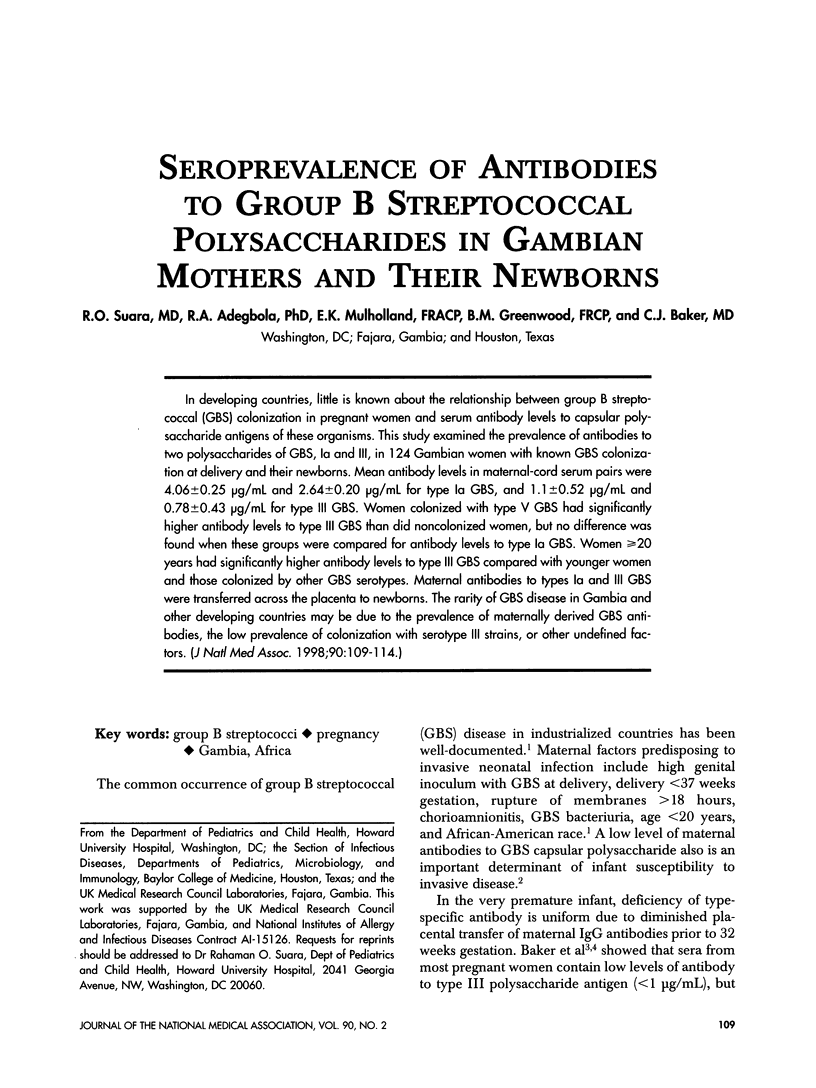
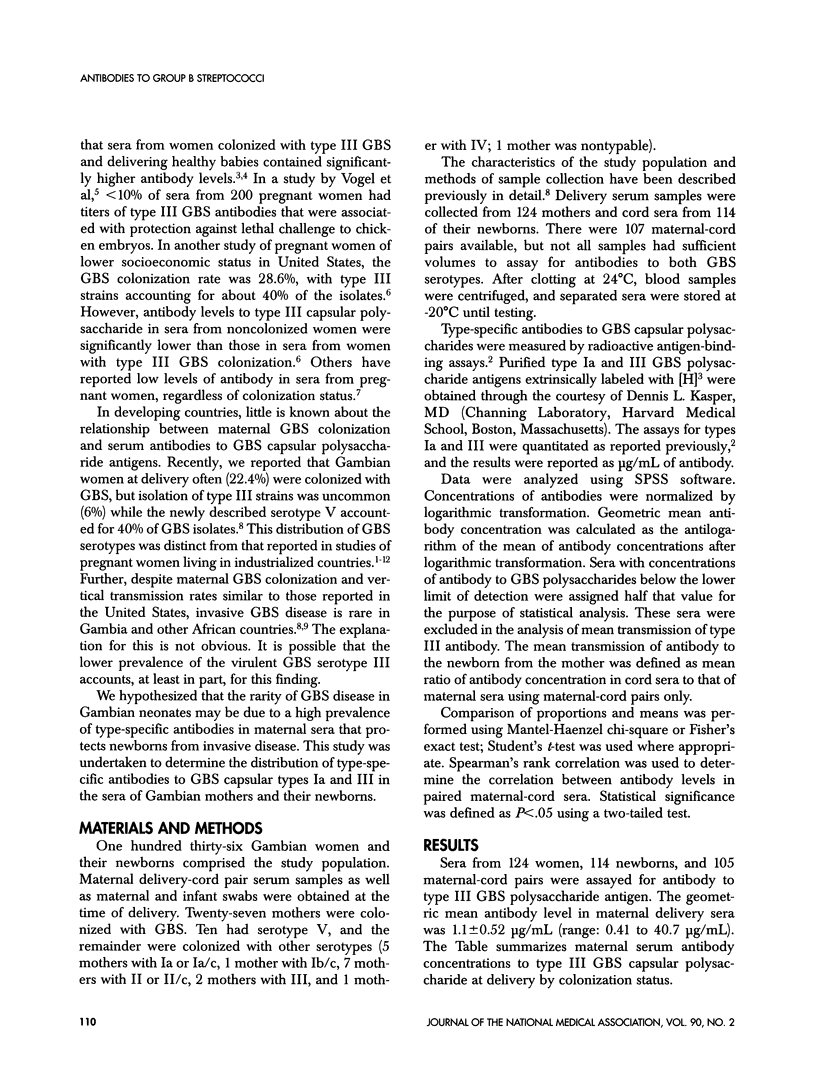
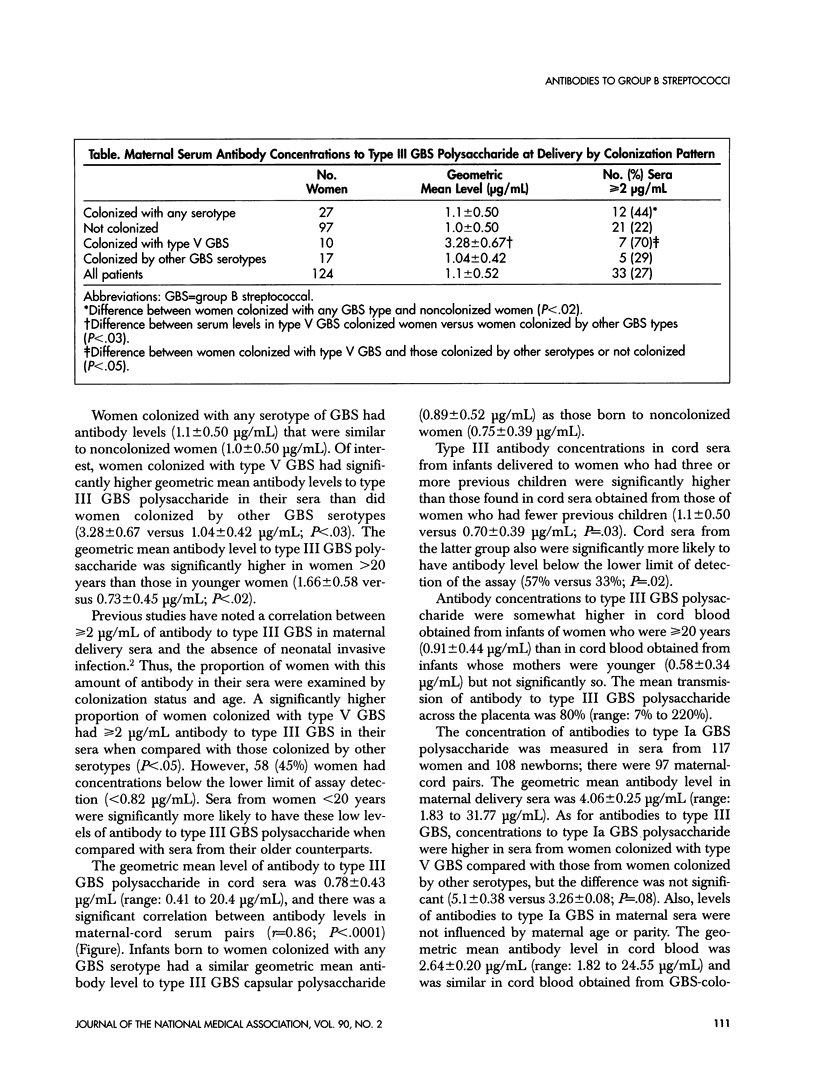
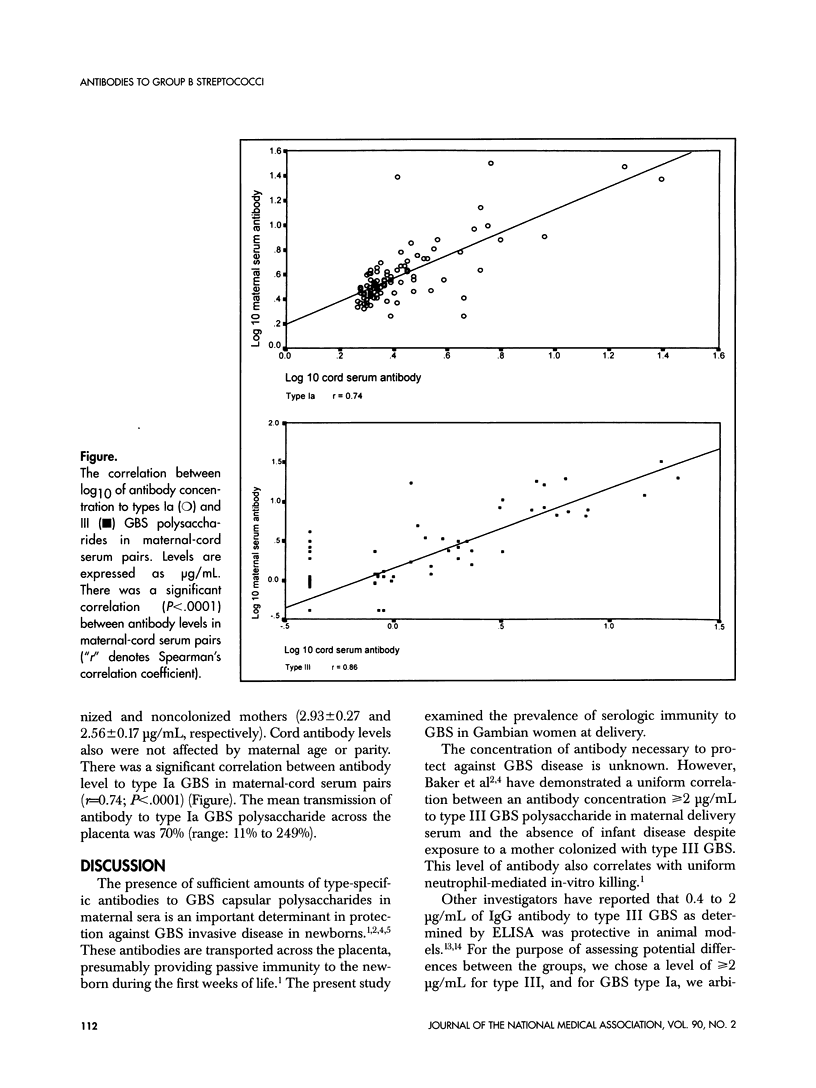
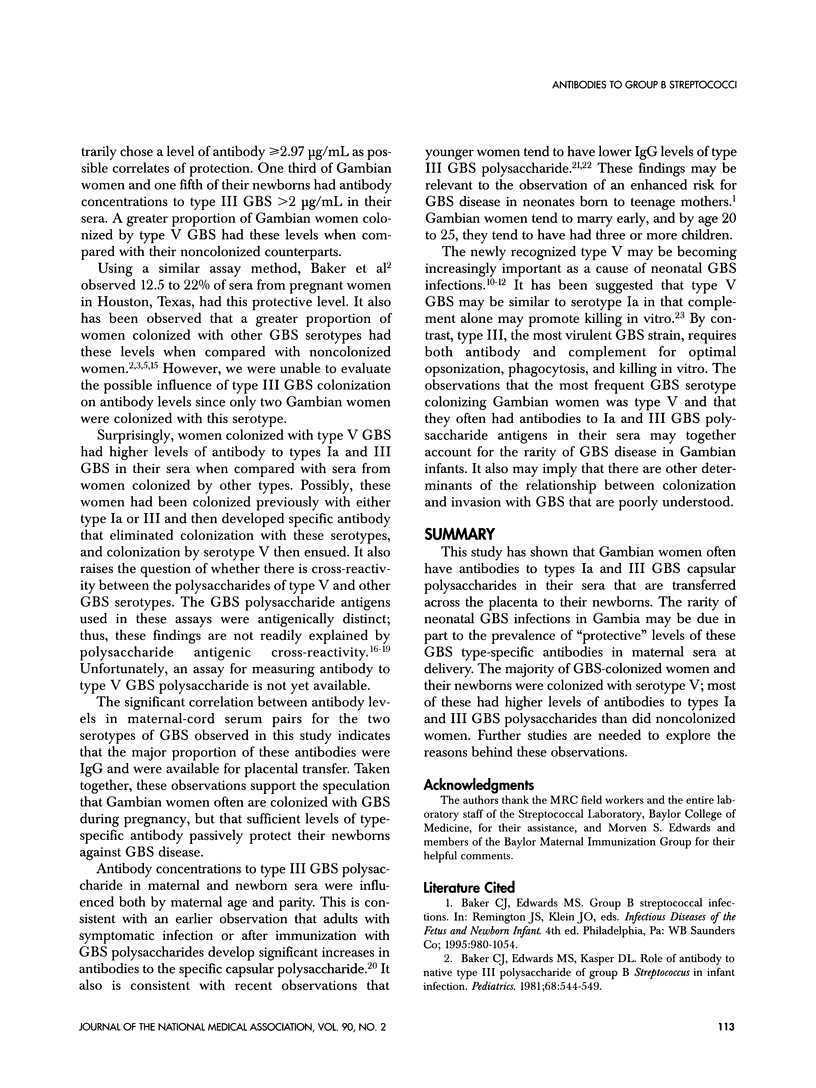
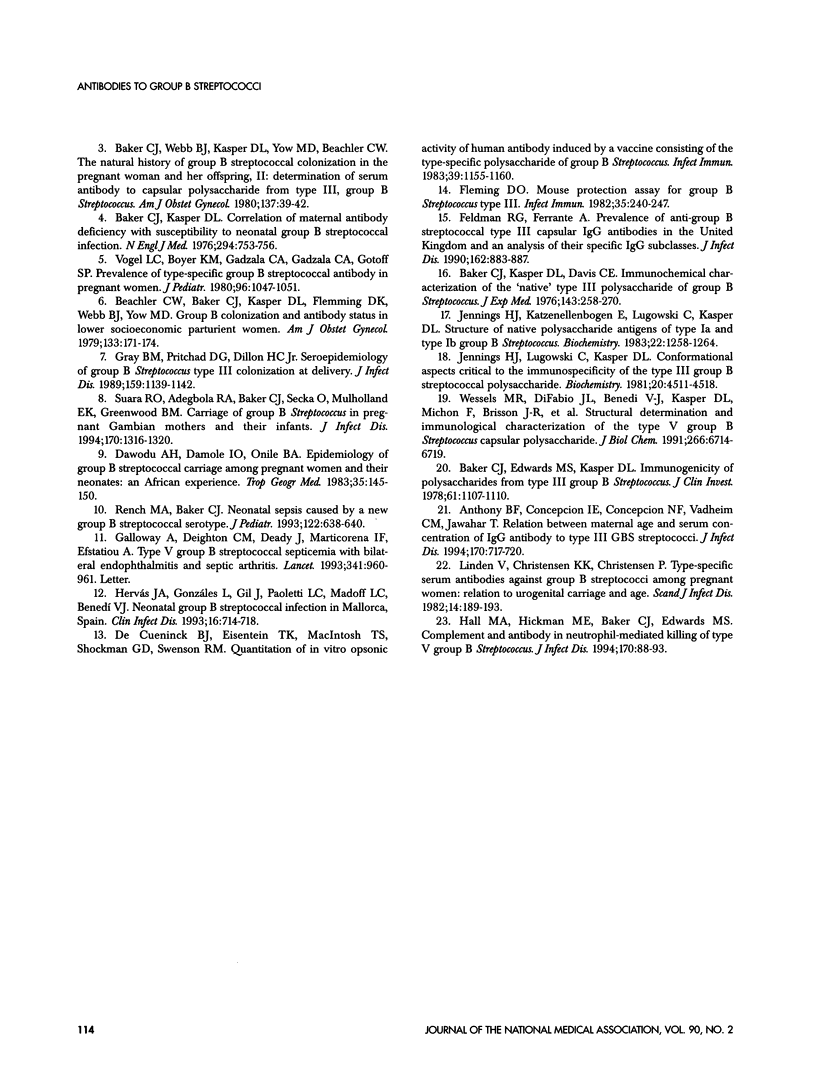
Selected References
These references are in PubMed. This may not be the complete list of references from this article.
- Anthony B. F., Concepcion I. E., Concepcion N. F., Vadheim C. M., Tiwari J. Relation between maternal age and serum concentration of IgG antibody to type III group B streptococci. J Infect Dis. 1994 Sep;170(3):717–720. doi: 10.1093/infdis/170.3.717. [DOI] [PubMed] [Google Scholar]
- Baker C. J., Edwards M. S., Kasper D. L. Immunogenicity of polysaccharides from type III, group B Streptococcus. J Clin Invest. 1978 Apr;61(4):1107–1110. doi: 10.1172/JCI109011. [DOI] [PMC free article] [PubMed] [Google Scholar]
- Baker C. J., Edwards M. S., Kasper D. L. Role of antibody to native type III polysaccharide of group B Streptococcus in infant infection. Pediatrics. 1981 Oct;68(4):544–549. [PubMed] [Google Scholar]
- Baker C. J., Kasper D. L. Correlation of maternal antibody deficiency with susceptibility to neonatal group B streptococcal infection. N Engl J Med. 1976 Apr 1;294(14):753–756. doi: 10.1056/NEJM197604012941404. [DOI] [PubMed] [Google Scholar]
- Baker C. J., Kasper D. L., Davis C. E. Immunochemical characterization of the "native" type III polysaccharide of group B Streptococcus. J Exp Med. 1976 Feb 1;143(2):258–270. doi: 10.1084/jem.143.2.258. [DOI] [PMC free article] [PubMed] [Google Scholar]
- Baker C. J., Webb B. J., Kasper D. L., Yow M. D., Beachler C. W. The natural history of group B streptococcal colonization in the pregnant woman and her offspring. II. Determination of serum antibody to capsular polysaccharide from type III, group B Streptococcus. Am J Obstet Gynecol. 1980 May 1;137(1):39–42. doi: 10.1016/0002-9378(80)90383-x. [DOI] [PubMed] [Google Scholar]
- Beachler C. W., Baker C. J., Kasper D. L., Fleming D. K., Webb B. J., Yow M. D. Group B streptococcal colonization and antibody status in lower socioeconomic parturient women. Am J Obstet Gynecol. 1979 Jan 15;133(2):171–173. doi: 10.1016/0002-9378(79)90470-8. [DOI] [PubMed] [Google Scholar]
- Dawodu A. H., Damole I. O., Onile B. A. Epidemiology of group B streptococcal carriage among pregnant women and their neonates: an African experience. Trop Geogr Med. 1983 Jun;35(2):145–150. [PubMed] [Google Scholar]
- De Cueninck B. J., Eisenstein T. K., McIntosh T. S., Shockman G. D., Swenson R. M. Quantitation of in vitro opsonic activity of human antibody induced by a vaccine consisting of the type III-specific polysaccharide of group B streptococcus. Infect Immun. 1983 Mar;39(3):1155–1160. doi: 10.1128/iai.39.3.1155-1160.1983. [DOI] [PMC free article] [PubMed] [Google Scholar]
- Feldman R. G., Ferrante A. Prevalence of anti-group B streptococcal type III capsular IgG antibodies in the United Kingdom and an analysis of their specific IgG subclasses. J Infect Dis. 1990 Oct;162(4):883–887. doi: 10.1093/infdis/162.4.883. [DOI] [PubMed] [Google Scholar]
- Fleming D. O. Mouse protection assay for group B streptococcus type III. Infect Immun. 1982 Jan;35(1):240–247. doi: 10.1128/iai.35.1.240-247.1982. [DOI] [PMC free article] [PubMed] [Google Scholar]
- Galloway A., Deighton C. M., Deady J., Marticorena I. F., Efstratiou A. Type V group B streptococcal septicaemia with bilateral endophthalmitis and septic arthritis. Lancet. 1993 Apr 10;341(8850):960–961. doi: 10.1016/0140-6736(93)91251-g. [DOI] [PubMed] [Google Scholar]
- Gray B. M., Pritchard D. G., Dillon H. C., Jr Seroepidemiology of group B streptococcus type III colonization at delivery. J Infect Dis. 1989 Jun;159(6):1139–1142. doi: 10.1093/infdis/159.6.1139. [DOI] [PubMed] [Google Scholar]
- Hall M. A., Hickman M. E., Baker C. J., Edwards M. S. Complement and antibody in neutrophil-mediated killing of type V group B streptococcus. J Infect Dis. 1994 Jul;170(1):88–93. doi: 10.1093/infdis/170.1.88. [DOI] [PubMed] [Google Scholar]
- Hervás J. A., González L., Gil J., Paoletti L. C., Madoff L. C., Benedí V. J. Neonatal group B streptococcal infection in Mallorca, Spain. Clin Infect Dis. 1993 May;16(5):714–718. doi: 10.1093/clind/16.5.714. [DOI] [PubMed] [Google Scholar]
- Jennings H. J., Katzenellenbogen E., Lugowski C., Kasper D. L. Structure of native polysaccharide antigens of type Ia and type Ib group B Streptococcus. Biochemistry. 1983 Mar 1;22(5):1258–1264. doi: 10.1021/bi00274a042. [DOI] [PubMed] [Google Scholar]
- Jennings H. J., Lugowski C., Kasper D. L. Conformational aspects critical to the immunospecificity of the type III group B streptococcal polysaccharide. Biochemistry. 1981 Aug 4;20(16):4511–4518. doi: 10.1021/bi00519a001. [DOI] [PubMed] [Google Scholar]
- Lindén V., Christensen K. K., Christensen P. Type-specific serum antibodies against group B streptococci among pregnant women: relation to urogenital carriage and age. Scand J Infect Dis. 1982;14(3):189–193. doi: 10.3109/inf.1982.14.issue-3.06. [DOI] [PubMed] [Google Scholar]
- Rench M. A., Baker C. J. Neonatal sepsis caused by a new group B streptococcal serotype. J Pediatr. 1993 Apr;122(4):638–640. doi: 10.1016/s0022-3476(05)83554-1. [DOI] [PubMed] [Google Scholar]
- Suara R. O., Adegbola R. A., Baker C. J., Secka O., Mulholland E. K., Greenwood B. M. Carriage of group B Streptococci in pregnant Gambian mothers and their infants. J Infect Dis. 1994 Nov;170(5):1316–1319. doi: 10.1093/infdis/170.5.1316. [DOI] [PubMed] [Google Scholar]
- Vogel L. C., Boyer K. M., Gadzala C. A., Gotoff S. P. Prevalence of type-specific group B streptococcal antibody in pregnant women. J Pediatr. 1980 Jun;96(6):1047–1051. doi: 10.1016/s0022-3476(80)80639-1. [DOI] [PubMed] [Google Scholar]
- Wessels M. R., DiFabio J. L., Benedì V. J., Kasper D. L., Michon F., Brisson J. R., Jelínková J., Jennings H. J. Structural determination and immunochemical characterization of the type V group B Streptococcus capsular polysaccharide. J Biol Chem. 1991 Apr 15;266(11):6714–6719. [PubMed] [Google Scholar]


